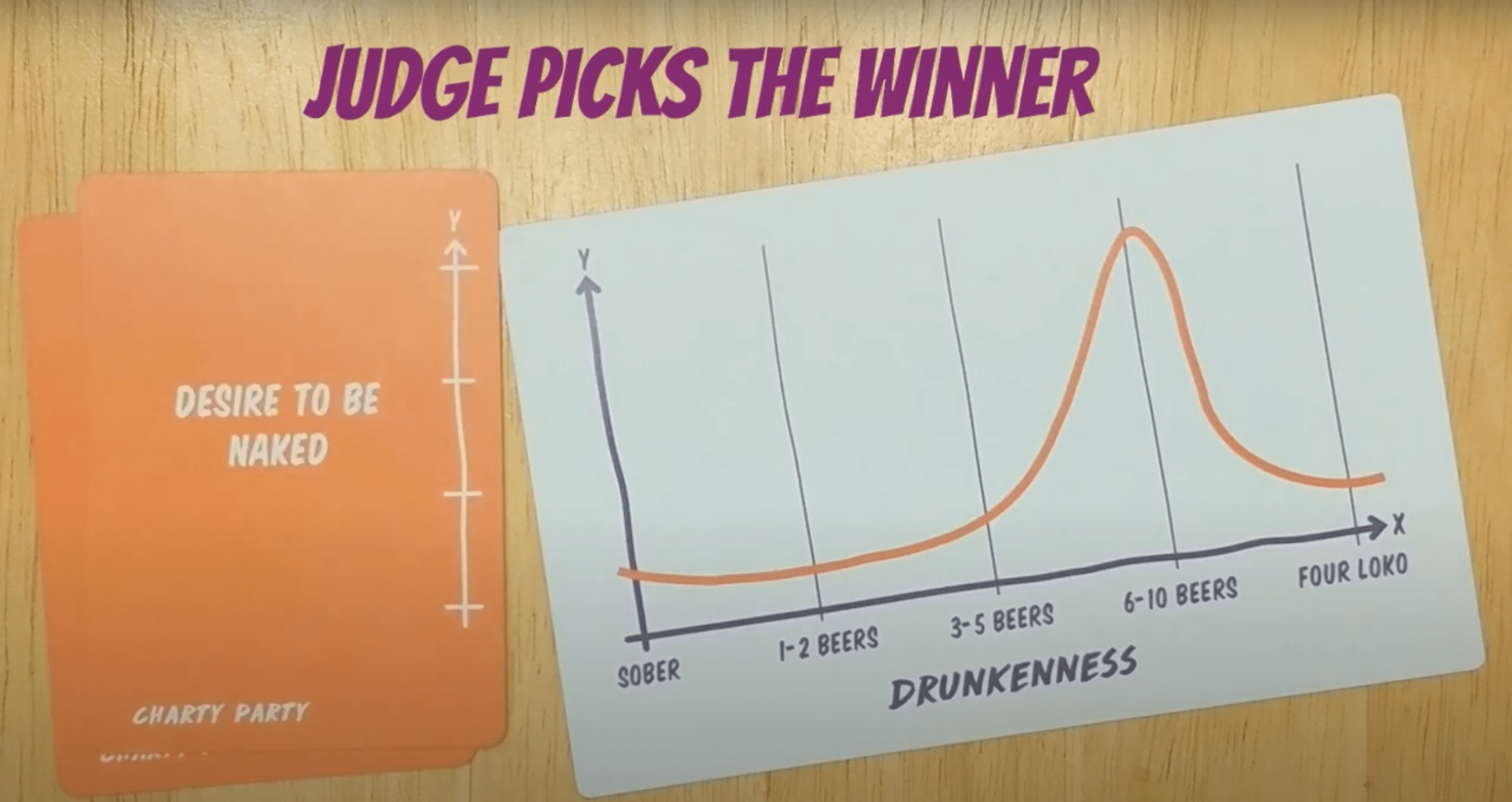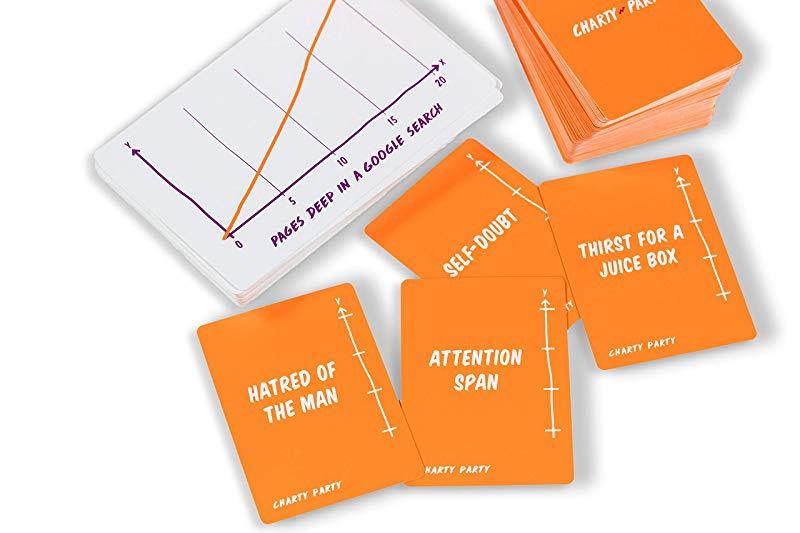About the Game
Who doesn’t love judging? There’s plenty of judgement to go around (literally) in the card game Charty Party by Evan Katz and Josh Roberts. The game’s distinguishable orange box gives us the following information: Charty Party is “The Game of Absurdly Funny Charts,” made for 3+ players who are ages 17+, with a play time of 30-90 minutes. Even without looking at the age range, I could tell that it’s target audience was adults by seeing cards like, “Time spent stalking your ex on Facebook” or “Dance moves involving aggressive butt-shaking” — probably not the most suitable images for the youngins. Moreover, it takes a certain age to appreciate having fun with math without being tricked into it.
Formal Elements
Players & Roles:
- The game can be played with 3 or more players.
- In each round (discussed more below), there is 1 judge and the rest of the players are all competitors.
Outcome & Objective:
- At the end of the game, the player with the most chart cards wins.
- So, each player’s goal is to beat all of the other players by accumulating the most chart cards.
Rules & Procedures:
- The game promises that you can “Learn to play in under a minute, even if you’re not a ‘math person’.” I’ll try to explain in about that time:
- To setup, every player is dealt 7 answer cards, with the remaining deck played in the center of the playing area.
- Players pick a judge to start the first round. The judge will rotate every round, going around in a circle continuously until the game stops.
- The judge draws a chart card, and the rest of the players play their funniest card to match with the chart. Submissions should be anonymous, so that the judge picks 1 winner based on the answer and not the player. The winning player for that round collects the chart card that they will add to their (hopefully) growing sum.
- Here’s an example from this instruction video by Evan Katz.

Resources:
- All that players are given are the answer and chart cards. The rest is up to their own sense of humor!
Boundaries:
- There’s a lot to imagine within the universe of Charty Party: why, exactly, does the “Desire to be naked” peak drastically at 6-10 beers, then drop when you’ve consumed a four loko? Because there’s so much imagining that each of the players needs to do when choosing the funniest card to play and that the judge needs to do in order to pick the funniest answer, the game creates its own little universe that players can’t easily tune out from.
- Rounds go relatively quickly, but there is no fixed time limit to how long the players can take to play their answer cards. I suppose players are limited by the other players’ patience for how long they can wait to move on to the next round.
Synthesizing these elements, the game seems really simple on paper: you get some cards, and you play them. But you have to picture so many different kinds of scenarios and justifications as you play this game, and I think that’s a pretty marvelous thing.
What Type of Fun?
I would classify this as a fellowship game. Most of the time, you’re just laughing your butt off with your fellow players. The fun and satisfaction of the game come from being around the people with whom you’re playing it, and the game is therefore a social framework.
In some ways, you could think of this game as an expression game, too. It takes creativity to come up with hilarious answers given the constraint of the 7 cards in your hand! Deciding at every point how to match your answers to the give the most LOL-ful answer takes creativity.
It would be amiss, however, not to give due credit to the hilarity of the answer cards themselves. “Desire to be naked”? Come on, that’s funny in itself. Matching it to a function or chart just takes the scenarios in which you can imagine an already-funny-concept to the next level.
The Game’s Flow and Areas for Improvement
The game requires little to no vulnerability between players because the answer submissions are anonymous. Moreover, the room for a grudge is pretty short because the judge rotates every round, meaning you can groan if you lose one round but hold out hope that you’ll get it next time.
As a player, the game went great when I had a packed hand (a lot of absurd cards that could go well in any situation), but it was frustrating when I had plainer cards in my hand. Sometimes, a plainer card just happens to go well with a chart card, but the wackiest card often wins.
This is my main suggested point of improvement: there should be a better balance between the plain-to-absurdity of cards. The reason being is that some cards are just so fantastic that they’d win no matter what the chart card was, which takes the fun out of that round because none of the other players would stand much of a chance.
Comparison to Other Games
Because it’s an adult game, I find it much more fun to play than Apples-to-Apples. I can make make pop culture references & middle-school-ish-sex jokes and try to match logically to the chart card.
As a long time Cards Against Humanity fan, I’m pleasantly surprised and will share that I felt more engaged playing Charty Party. The “mathematical” component was a lot of fun to think about, and it wasn’t just an A-B match but also a reasoning for why the function changes the way it does (i.e. a huge exponential curve for the pages deep in a Google search). I’ll definitely be playing this game again at my next game night with friends.



